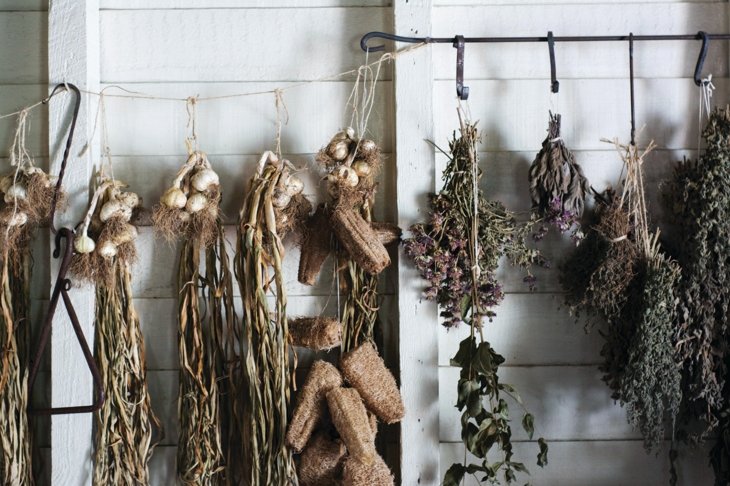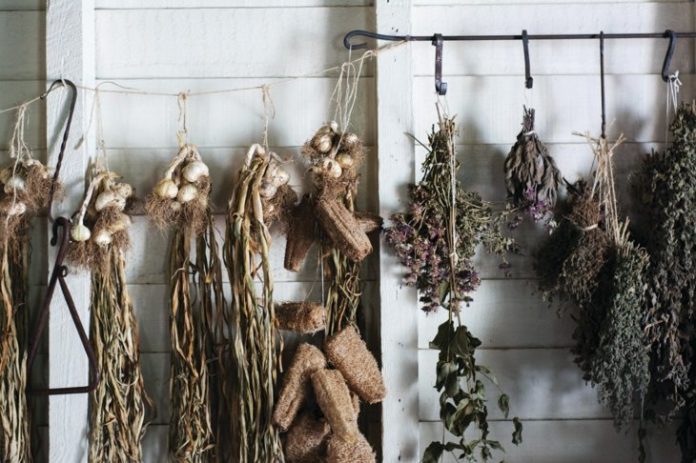
We tend to think of stress as a modern malady, but you’d better believe that the pharaohs of ancient Egypt and the emperors of Rome suffered their fair share of anxious moments.* The herbs ancient civilizations used to soothe stress can still benefit us today in #thesetryingtimes—especially the 10 botanical beauties listed here.
Many of us are newly discovering the power of herbal medicines (that’s 2020 for you), but archeological excavations show that humans have been using plants for medicinal purposes for 60,000 years. The oldest surviving written record of medicinal plant use dates from 1500 BC in Egypt. Sophisticated systems of medical treatment developed centuries ago, such as traditional Chinese medicine and Ayurveda, are still widely used today and are largely based on botanicals.
Ashwagandha
Botanical name: Withania somnifera
What it is
- used for more than 3,000 years as one of Ayurveda’s most prominent rasayanas (life extenders)
- classified as an adaptogen (an herb that helps our body manage stress)
What it looks like
- the plant: small shrub with yellow flowers native to India and North Africa
- the supplements: extracts or powders from the roots or leaves
What it does
- reduces physiological and biochemical indicators of stress
- corrects imbalances in the neuroendocrine and immune systems
- significantly reduces anxiety and stress
- regulates chemical signaling in the nervous system by blocking the stress pathway in the brain
Asian ginseng
Botanical name: Panax ginseng
What it is
- used for centuries in traditional Chinese medicine
- classified as an adaptogen
What it looks like
- the plant: light-colored, slow-growing, short plant with fleshy fork-shaped roots and oval-shaped green leaves
- the supplements: extracts, capsules, or powders from its roots
What it does
- supports cognitive function and/or reduces mental fatigue in cases of mental stress
- boosts mental alertness and remedies low energy
- helps alleviate anxiety and depression caused by stress
- ameliorates inflammatory diseases caused by stress
Chamomile
Botanical name: Matricaria chamomilla
What it is
- herb used for thousands of years; known in ancient Egypt, Greece, and Rome
- dried flowers have been used in teas for centuries as a remedy for several health conditions
What it looks like
- the plant: daisy-like flowers belonging to the aster plant family
- the supplements: flowering tops of chamomile are used to make supplements, extracts, and teas
What it does
- as an extract is used to improve sleep quality
- possibly reduces number of nighttime awakenings
- may moderately improve daytime functioning
- may help reduce anxiety and distress associated with menstrual period pain
Holy basil (tulsi)
Botanical name: Ocimum sanctum
What it is
- Ayurvedic herb known as “the incomparable one;” revered as an “elixir of life”
- classified as an adaptogen
What it looks like
- the plant: small aromatic shrub with green or purple leaves and small purplish or red flowers; used in cooking for its pungent aroma and a flavor that’s similar to other varieties of basil
- the supplements: tablets, capsules, teas, and essential oils
What it does
- may decrease symptoms of stress, including forgetfulness, exhaustion, and sleep problems
- reduces anxiety and associated stress
- may help reduce depression in those with anxiety
- helps protect against damage caused by physiological and metabolic stress
Lavender
Botanical name: Lavandula angustifolia
What it is
- used to make medicines, as well as perfumes, soaps, flavorings, and crafts since before medieval times
- popular as an essential oil, which is distilled from its flower spikes
What it looks like
- the plant: shrub with varieties ranging from 9 inches to 3 feet tall with aromatic purple flowers
- the supplements: dried powders, capsules, and tinctures; however, its essential oil is used primarily in aromatherapy
What it does
- tincture of lavender may help improve symptoms of depression
- oral use of lavender oil supplement may help reduce anxiety
- may improve symptoms (waking frequency/duration and anxiety) in PTSD and chronic fatigue
- can help treat insomnia and reduce anticipatory anxiety
Lemon balm
Botanical name: Melissa officinalis
What it is
- a lemon-scented herb from the mint family used for more than 2,000 years
- contains chemicals that generate a sedative, calming effect; also may have antiviral effects, as well as benefits for digestive health
What it looks like
- the plant: small, perennial herb with appearance that’s similar to others in the mint family
- the supplements: tablets, capsules, tinctures, teas, essential oils, and salves (used for treating viral skin conditions like cold sores)
What it does
- helps improve mood and cognitive performance
- can reduce some symptoms of anxiety, including nervousness and excitability
- may increase calmness and alertness
- helps reduce sleep disturbances and improve sleep overall by alleviating anxiety
Passion flower
Botanical name: Passiflora incarnate
What it is
- has been used since the 16th century as a mild sedative
- flowers, berries, roots, and leaves have been used as a traditional natural medicine
What it looks like
- the plant: purple/blue and yellow vine flower found throughout South America and southern USA
- the supplements: capsules, tablets, and teas (available in single or combination formulations)
What it does
- has significant anxiety-calming effects
- by reducing anxiety, has also been shown to help increase concentration
- increases levels of the brain chemical gamma-aminobutyric acid (GABA), which helps regulate mood
- helps modulate circadian rhythms to regulate sleep-wake cycles and aid in treating sleep disorders
Rhodiola
Botanical name: Rhodiola rosea
What it is
- used for centuries in Russia and Scandinavian countries for anxiety, fatigue, and depression
- adaptogenic herb with beneficial effects on adrenal function
What it looks like
- the plant: perennial yellow flowering herb native to cold, mountainous regions of Europe and Asia
- the supplements: capsules or tablets from its roots
What it does
- helps reduce stress-related fatigue
- helps increase concentration in those with burnout stress
- has been shown to improve mood in depressed adults
- may help improve attention and memory and enhance ability to cope with stress
St. John’s wort
Botanical name: Hypericum perforatum
What it is
- used for centuries; originally harvested for the feast of St. John the Baptist
- widely prescribed for depression in Europe and sold as a supplement in North America
What it looks like
- the plant: small flowering plant with yellow blossoms that grows throughout North America
- the supplements: teas, tablets, capsules, and topical treatments
What it does
- affects brain’s uptake of the mood-modulating chemicals serotonin, dopamine, and norepinephrine
- may be as effective as SSRIs and more effective than placebos in mild-to-moderate depression
- may help improve response to stress
- could have anxiety-relieving properties due to its effects on GABA transmitters
Turmeric
Botanical name: Curcuma longa
What it is
- spice widely used for more than 4,000 years throughout Asia in cooking, cosmetics, and remedies
What it looks like
- the plant: the root of Curcuma longa, a flowering plant of the ginger family
- the spice: deep golden yellow powder that’s often referred to as Indian saffron
- the supplements: tablets or capsules that typically contain its main active compound, curcumin
What it does
- has shown promise in treating symptoms of major depression
- may help reverse harmful brain changes induced by chronic stress
- promotes resilience to stress and may help reduce anxiety
- seems to help reverse the effects of chronic stress on behavior
A glossary of herbal remedies
Infusion
Boiling water is poured over dried flowers, fruit, leaves, and other plant parts to make a tea. Cold infusions may also be made.
Decoction
Plant materials, including the bark, rhizomes, roots, or other woody parts, are boiled in water to make a tea. A decoction is generally more potent than an infusion.
Tincture
Herbs are soaked in a dark place in glycerin, alcohol, or vinegar for two to six weeks, and then the tincture is strained from the plant material. Note that glycerin can come from animal or plant sources.
Essential oil
A highly concentrated aromatic volatile oil extracted from the leaves, stems, flowers, and other parts of a plant. Essential oils are usually diluted before use.
Herbal infused oil
Volatile oils are extracted from plants by soaking the plants in a carrier oil for approximately two weeks and then straining the oil before use.
Cream
Herbs are mixed in a water-based preparation to make a cream, which allows for absorption from the surface of the skin.
Salve
A salve is an ointment made from a heated mixture of oil and wax; it lasts longer on the skin than a water-based cream.





















